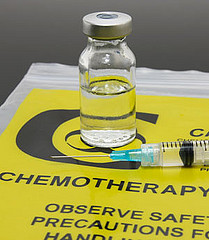Non-Hodgkin’s Lymphoma Treatment
Non-Hodgkin’s lymphoma represents a monoclonal proliferation of lymphoid cells and may be of B cell or T cell origin. The incidence of theses tumors increases with age, to 68.8 million populations per year at age 75, and the overall rate is increasing at about 3% per year.
The difficulties of establishing a reproducible and clinically useful histological classification of NHL are reflected in the larger number of classification systems to date. The current WHO classification stratifies according to cell lineages.
Clinically the most important factor is grade, which is a reflection of proliferation rate. High grade NHL has high proliferation rates, rapidly produces symptoms, is fetal if untreated, but is potentially curable.
Low grade NHL has low proliferation rates, may be asymptomatic for many months before presentation, runs an indolent course, but is not curable by conventional therapy. Of all case of NHL, 85% are either high-grade diffuse large cell NHL or low grade follicular NHL. Other forms of NHL, including mantle cell Non Hodgkin’s lymphoma and malt lymphomas, are less common.
Clinical features of NHL is often disseminated at presentation and have unexpected weight loss, sweats, fever, itching, loss of appetite, swollen lymph nodes in the neck, underarms, groin, coughing, breathlessness and chest pain, fatigue and weakness ,abdominal pain causing nausea, vomiting and constipation with headaches, mood disorder and other personality disorders as common symptoms for NHL.
To investigate it doctors examine the swollen lymph nodes present at different parts along with the patient’s Medical history, routine checkup report of bone marrow , complete blood test report, CT scans and X rays, Immunoglobulin determinations, measure of uric acid levels, HIV and AIDS test report.
Overweight people are on high risk with hepatitis C, AIDS, or HIV is at high risk of NHL. Other factors includes risk are age, gender, chemical exposure, radiation exposure, deficiency in the immune system, at times genetic syndromes and other infections.
Non Hodgkin’s Lymphoma Treatment Options
A symptomatic patient may not require therapy. Indications for treatment include marked systematic symptoms, lymphadenopathy causing discomfort or disfigurement, bone marrow failure or compression syndromes. Following are the stages of NHL used for treatment.
Stage I- cancer is sited only at one place or lymph of organ.
Stages II- cancer cell are present in one or more lymph of organ.
Stage III- it is present at both lymph node and diaphragm of organ.
Stage IV- one or more organ or area outside lymph has cancer cell.
The options for treatment are:
Radiotherapy
This can used for localized stage I disease, which are rare.
Chemotherapy
This is the mainstay of therapy. Most patients will respond to oral therapy with chlorambucil, which is well to rated. More intensive intravenous chemotherapy in younger patients produces better quality of life but no survival benefit. Neither therapy will cure patients.
Monoclonal antibody therapy
Humanized monoclonal antibodies can be used to target surface antigens on tumor cells, and induce tumor cell apoptosis directly. The anti-CD20 antibody rituximab had been shown to induce durable clinical responses in up to 60% of patients.
At present in England and Wales, it is only recommended at last-line therapy for stage III and IV follicular Non-Hodgkin’s lymphoma. Synergistic effects are seen when treatment is combined with standard chemotherapy, and trails are under way to define its optimal usage.
Patients with high grade NHL need treatment at initial presentation.
Chemotherapy
The majority (>90%) will need intravenous combination chemotherapy. The CHOP regimen (cyclophosphamide, doxorubicin, vincristine and prednisolone) remains the mainstay of therapy.
Radiotherapy
A few stage I patients without bulky disease may be suitable for radiotherapy. Radiotherapy is indicated for a residual localized site of bilk disease after chemotherapy, and spinal cord and other compression syndromes.
Monoclonal antibody therapy
When combined with CHOP chemotherapy, rituximab(R) increase the complete response rates and improves overall survival. The combination of R-CHOP is currently recommended for those with stage II or greater diffuse large-cell lymphoma as first line therapy.
Transplantation
Autologous stem cell transplantation benefits patients with relapsed chemosensitive disease.
Non Hodgkin’s Disease Survival rate
Low grade NHL runs an indolent remitting and relapsing course, with an overall median survival of 10 years. Transformation to higher grade NHL is associated with poor survival.
In high grade NHL, some 80% of patients overall respond initially to therapy but only 35% will have disease-free survival at 5 years. The prognosis for patients with NHL is further refined according to the international prognostic index (IPI).
For high grade NHL, 5 year survival ranges from 75% in those with low risk scores (<60, stage 1 or II, one fewer extra-nodal site, normal LDH and good performance status) to 25% on those with high risk scores (increasing age, advanced stage, concomitant disease and a raised LDH)
Relapse is associated with a poor response to further chemotherapy (<10%, 5 year survival), but in patients under 65 years, stem cell transplantation improves survival.
Hope now you know modern Non-Hodgkin’s disease treatment options.


Leave a Reply